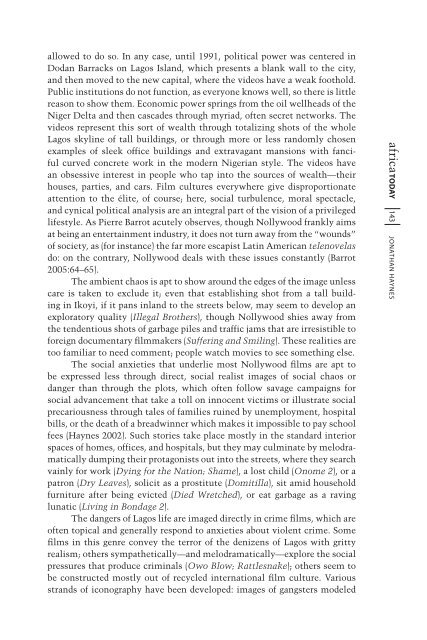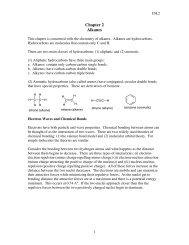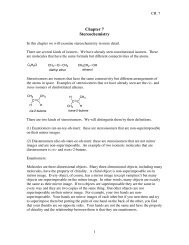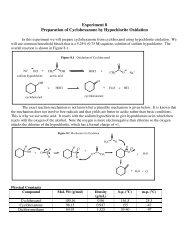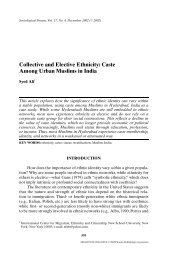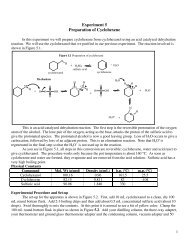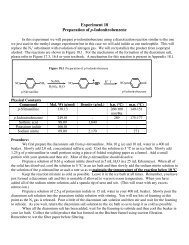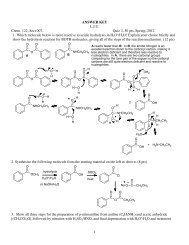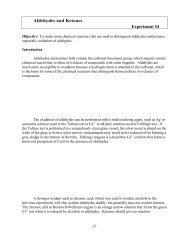Lagos is the ground of the films, not just in the sense that ... - myweb
Lagos is the ground of the films, not just in the sense that ... - myweb
Lagos is the ground of the films, not just in the sense that ... - myweb
Create successful ePaper yourself
Turn your PDF publications into a flip-book with our unique Google optimized e-Paper software.
allowed to do so. In any case, until 1991, political power was centered <strong>in</strong>Dodan Barracks on <strong>Lagos</strong> Island, which presents a blank wall to <strong>the</strong> city,and <strong>the</strong>n moved to <strong>the</strong> new capital, where <strong>the</strong> videos have a weak foothold.Public <strong>in</strong>stitutions do <strong>not</strong> function, as everyone knows well, so <strong>the</strong>re <strong>is</strong> littlereason to show <strong>the</strong>m. Economic power spr<strong>in</strong>gs from <strong>the</strong> oil wellheads <strong>of</strong> <strong>the</strong>Niger Delta and <strong>the</strong>n cascades through myriad, <strong>of</strong>ten secret networks. Thevideos represent th<strong>is</strong> sort <strong>of</strong> wealth through totaliz<strong>in</strong>g shots <strong>of</strong> <strong>the</strong> whole<strong>Lagos</strong> skyl<strong>in</strong>e <strong>of</strong> tall build<strong>in</strong>gs, or through more or less randomly chosenexamples <strong>of</strong> sleek <strong>of</strong>fice build<strong>in</strong>gs and extravagant mansions with fancifulcurved concrete work <strong>in</strong> <strong>the</strong> modern Nigerian style. The videos havean obsessive <strong>in</strong>terest <strong>in</strong> people who tap <strong>in</strong>to <strong>the</strong> sources <strong>of</strong> wealth—<strong>the</strong>irhouses, parties, and cars. Film cultures everywhere give d<strong>is</strong>proportionateattention to <strong>the</strong> élite, <strong>of</strong> course; here, social turbulence, moral spectacle,and cynical political analys<strong>is</strong> are an <strong>in</strong>tegral part <strong>of</strong> <strong>the</strong> v<strong>is</strong>ion <strong>of</strong> a privilegedlifestyle. As Pierre Barrot acutely observes, though Nollywood frankly aimsat be<strong>in</strong>g an enterta<strong>in</strong>ment <strong>in</strong>dustry, it does <strong>not</strong> turn away from <strong>the</strong> “wounds”<strong>of</strong> society, as (for <strong>in</strong>stance) <strong>the</strong> far more escap<strong>is</strong>t Lat<strong>in</strong> American telenovelasdo: on <strong>the</strong> contrary, Nollywood deals with <strong>the</strong>se <strong>is</strong>sues constantly (Barrot2005:64–65).The ambient chaos <strong>is</strong> apt to show around <strong>the</strong> edges <strong>of</strong> <strong>the</strong> image unlesscare <strong>is</strong> taken to exclude it; even <strong>that</strong> establ<strong>is</strong>h<strong>in</strong>g shot from a tall build<strong>in</strong>g<strong>in</strong> Ikoyi, if it pans <strong>in</strong>land to <strong>the</strong> streets below, may seem to develop anexploratory quality (Illegal Bro<strong>the</strong>rs), though Nollywood shies away from<strong>the</strong> tendentious shots <strong>of</strong> garbage piles and traffic jams <strong>that</strong> are irres<strong>is</strong>tible t<strong>of</strong>oreign documentary filmmakers (Suffer<strong>in</strong>g and Smil<strong>in</strong>g). These realities aretoo familiar to need comment; people watch movies to see someth<strong>in</strong>g else.The social anxieties <strong>that</strong> underlie most Nollywood <strong>films</strong> are apt tobe expressed less through direct, social real<strong>is</strong>t images <strong>of</strong> social chaos ordanger than through <strong>the</strong> plots, which <strong>of</strong>ten follow savage campaigns forsocial advancement <strong>that</strong> take a toll on <strong>in</strong>nocent victims or illustrate socialprecariousness through tales <strong>of</strong> families ru<strong>in</strong>ed by unemployment, hospitalbills, or <strong>the</strong> death <strong>of</strong> a breadw<strong>in</strong>ner which makes it impossible to pay schoolfees (Haynes 2002). Such stories take place mostly <strong>in</strong> <strong>the</strong> standard <strong>in</strong>teriorspaces <strong>of</strong> homes, <strong>of</strong>fices, and hospitals, but <strong>the</strong>y may culm<strong>in</strong>ate by melodramaticallydump<strong>in</strong>g <strong>the</strong>ir protagon<strong>is</strong>ts out <strong>in</strong>to <strong>the</strong> streets, where <strong>the</strong>y searchva<strong>in</strong>ly for work (Dy<strong>in</strong>g for <strong>the</strong> Nation; Shame), a lost child (Onome 2), or apatron (Dry Leaves), solicit as a prostitute (Domitilla), sit amid householdfurniture after be<strong>in</strong>g evicted (Died Wretched), or eat garbage as a rav<strong>in</strong>glunatic (Liv<strong>in</strong>g <strong>in</strong> Bondage 2).The dangers <strong>of</strong> <strong>Lagos</strong> life are imaged directly <strong>in</strong> crime <strong>films</strong>, which are<strong>of</strong>ten topical and generally respond to anxieties about violent crime. Some<strong>films</strong> <strong>in</strong> th<strong>is</strong> genre convey <strong>the</strong> terror <strong>of</strong> <strong>the</strong> denizens <strong>of</strong> <strong>Lagos</strong> with grittyreal<strong>is</strong>m; o<strong>the</strong>rs sympa<strong>the</strong>tically—and melodramatically—explore <strong>the</strong> socialpressures <strong>that</strong> produce crim<strong>in</strong>als (Owo Blow; Rattlesnake); o<strong>the</strong>rs seem tobe constructed mostly out <strong>of</strong> recycled <strong>in</strong>ternational film culture. Variousstrands <strong>of</strong> iconography have been developed: images <strong>of</strong> gangsters modeledafrica today 143 Jonathan Haynes


